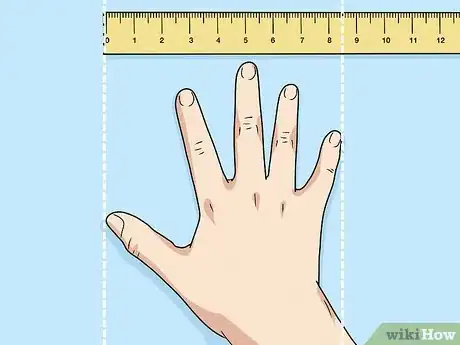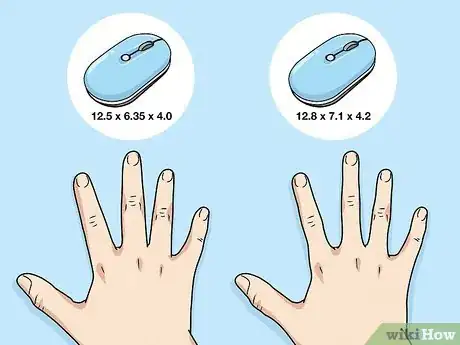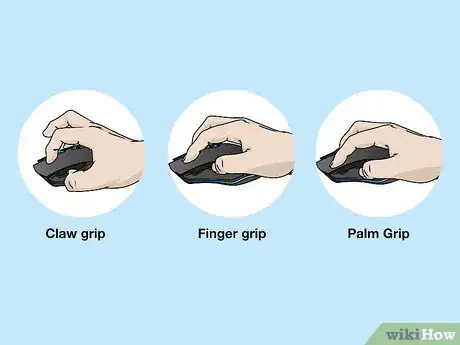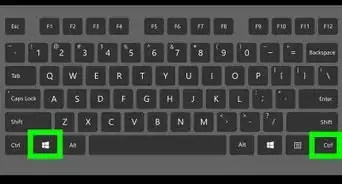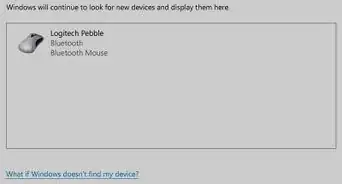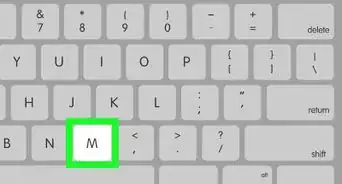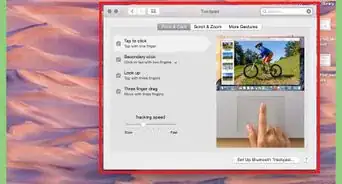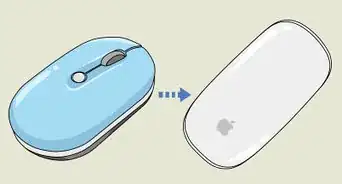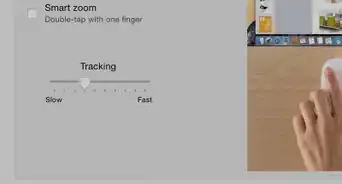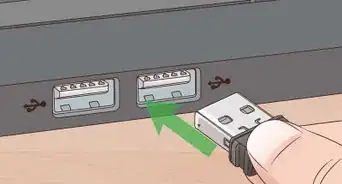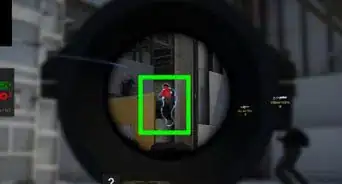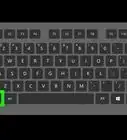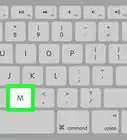This article was co-authored by wikiHow Staff. Our trained team of editors and researchers validate articles for accuracy and comprehensiveness. wikiHow's Content Management Team carefully monitors the work from our editorial staff to ensure that each article is backed by trusted research and meets our high quality standards.
There are 11 references cited in this article, which can be found at the bottom of the page.
This article has been viewed 18,768 times.
Learn more...
If you spend a lot of time on the computer, the right mouse can make your working, gaming, or creating experience far more comfortable. But in order to determine whether a particular mouse is a good fit for your hand, you’ll first need to have an idea of how big your hand is. This is often as simple as measuring the length and width of your hand, then comparing your unique measurements to the dimensions of the model you’re looking at.
Steps
Measuring Your Hand
-
1Grab a ruler or tape measure, a piece of paper, and something to write with. One of these measuring devices will help you get an accurate sense of your hand’s proportions. Since both tools are easy to maneuver one-handed and have increments labelled in inches and centimeters, either one will work equally well.[1]
- If you don’t happen to have either of these implements handy, another option is to download a measuring app to your smartphone or tablet. These use your device’s camera to gauge the size of various objects in your environment.[2]
- Measuring a hand isn't a particularly complicated procedure, so your paper only needs to be big enough for you to jot down a couple of numbers.
- Being able to refer back to your measurements will be helpful later on when it comes time to shop for a new mouse.
-
2Lay your hand flat against a table, desk, or countertop. You can turn it palm-up or palm-down, whichever position is more comfortable for you. Hold your fingers together and extend them to their full length. You’re now ready to begin measuring with your other hand.[3]
- Avoid spreading your fingers wide or relaxing your hand and allowing it to curl inwards. The idea here is to approximate the position your hand will be while you’re using the mouse.
Advertisement -
3Find the length of your hand from your wrist to the tip of your middle finger. Align the end of your ruler or tape measure with the crease at the base of your hand. Then, look up to the point where your middle finger ends and note the number beside it. Write this number down on your nearby sheet of paper.[4]
- If you’re working with a tape measure, you can actually snag the hooked end onto the “lip” formed by the lower part of your palm to hold it in place while you extend the tape.
Tip: For the sake of precision, make all your measurements to the nearest tenth of a centimeter (0.0039 in).
-
4Determine the width of your hand by measuring straight across your palm. This time, start with the end of your device just above your thumb joint and stretch it horizontally to the pinky-side edge. Copy down the number you see alongside your length measurement, remembering to round off to the nearest tenth of an inch (0.25 cm).[5]
- Be sure to clearly label each measurement so you’ll know which is which at a glance.
- Your hand's length and width dimensions should be all you need to track down a mouse that feels like it was made especially for you!
Selecting a Suitably-Sized Mouse
-
1Pull up the size chart provided by the mouse’s manufacturer. Head to the website of the company that makes the mouse you’ve been looking at. Once you’re there, search for a link that says something like “Size Chart” or “Sizing Guide.” The provided graphic will give you a better sense of which size will be best for you.[6]
- Assuming you don’t have your eye on any specific model, you’ll find a multitude of size charts to look over online.[7]
- Most companies that specialize in ergonomic computer accessories offer sizing guides meant to help first-time customers find the perfect fit.
Warning: Keep in mind that different charts may give slightly different size recommendations, since they were created with different designs in mind.
-
2See which size is best suited for your measurements. Mice typically come in standard sizes like small, medium, and large. With this in mind, the size chart provided by the manufacturer may recommend a small mouse for hands shorter than about 16.9 centimetres (6.7 in), a medium for those in the 17–19.5 cm (6.7–7.7 in) range, and a large for those longer than 19.6 centimetres (7.7 in).[8]
- Some mice can get as small as 7.9 cm (3.1 in) and as large as 13.9 cm (5.5 in).[9]
- If you have wider-than-average hands, you might be more comfortable with a large mouse, even if they don't exceed the length dimensions listed for the medium size.
-
3Go a size down if you have thick hands and a size up if they’re on the thin side. If your hand measurements fall between two of the sizes listed on the chart, most manufacturers advise making your decision based on the thickness of your palm. This is to ensure that your hand hovers at a natural height over the desktop.
- If your mouse is too short, your fingertips may drag the desktop, which can be distracting and potentially irritating. If it’s too tall, it could make your movements feel awkward and unwieldy.
-
4Choose a mouse that’s designed for your preferred grip style. Mouse grips can generally be classified into one of three categories: palm, claw, and fingertip. With a palm grip, your palm lies flat against the top of the mouse and you use most of your hand to push the mouse around. With a claw grip, you clamp your fingers down over the sides of the mouse for greater precision and control. A fingertip grip is just what it sounds like—you manipulate the mouse with just your fingertips while keeping the rest of your hand arched above.[10]
- Manufacturers will often specify which grip style a particular model is best suited for somewhere in the product description.
- The majority of people favor a basic palm grip for simple work-related tasks, while the claw and fingertip grips can be advantageous when playing games that require highly accurate or fast, twitchy movements.[11]
-
5Try out a different size if you’re not happy with the one you ordered. In rare cases, the size suggested by the manufacturer may not actually be the one you need—after all, each hand is a little different. If this happens, simply exchange your mouse for another size that you think might be a better match.[12]
- When swapping out one mouse for another, consider factors like the contouring of the palm section and the resting position of your fingers as well as the length, width, and height dimensions.
Warnings
- Mice aren’t one-size-fits-all accessories. Spending hours and hours using one that’s too big or too small can result in issues like strained or cramped muscles, joint pain, or general discomfort.⧼thumbs_response⧽
Things You’ll Need
Measuring Your Hand
- Ruler or tape measure
- Scrap paper
- Pen or pencil
Selecting a Suitably-Sized Mouse
- Mouse size chart
References
- ↑ https://choosehandsafety.org//choosing-hand-tools/hand-tool-size
- ↑ https://joyofandroid.com/best-measuring-apps-for-android/
- ↑ https://thegamingsetup.com/gaming-mouse/buying-guides/mouse-size-chart-table
- ↑ https://cdn.shopify.com/s/files/1/0729/3389/files/How_to_Measure_your_Hand_Size.pdf?6032
- ↑ http://www.glove.org/Modern/glovemeasure.php
- ↑ https://medium.com/@Xander51/how-i-learned-to-stop-using-large-mice-and-measure-my-hand-a-shoutout-to-rocketjumpninja-947430df6521
- ↑ https://www.wepc.com/tips/mouse-size-chart/
- ↑ https://www.wepc.com/tips/mouse-size-chart/
- ↑ https://thegamingsetup.com/gaming-mouse/buying-guides/mouse-size-chart-table



